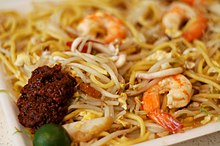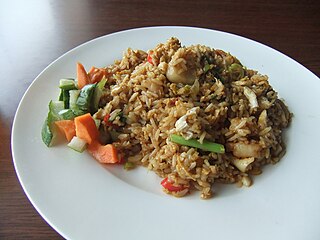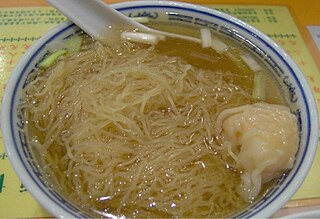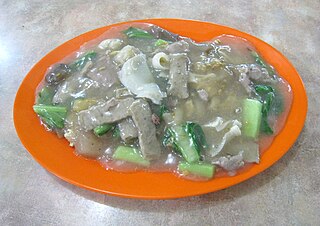This article does not cite any sources .(December 2009) (Learn how and when to remove this template message) |
 | |
| Type | Noodle soup |
|---|---|
| Main ingredients | Prawns, egg noodles, stock, pork, fish cake slices, bean sprouts, shallots, spring onions |
| Hae mee | |||||||||||||||
 | |||||||||||||||
| Traditional Chinese | 蝦麵 | ||||||||||||||
|---|---|---|---|---|---|---|---|---|---|---|---|---|---|---|---|
| Simplified Chinese | 虾面 | ||||||||||||||
| Literal meaning | Prawn noodles | ||||||||||||||
| |||||||||||||||
Hae mee (also called prawn mee,台罗拼音:he5-mi7) is a noodle soup dish popular in Malaysia and Singapore. It can also refer to a fried noodle dish known as Hokkien mee. The dish's name literally means "prawn noodles" in Hokkien.

Noodle soup refers to a variety of soups with noodles and other ingredients served in a light broth. Noodle soup is common dish across East and Southeast Asia. Various types of noodles are used, such as rice noodles, wheat noodles and egg noodles.

Malaysia is a country in Southeast Asia. The federal constitutional monarchy consists of 13 states and three federal territories, separated by the South China Sea into two similarly sized regions, Peninsular Malaysia and East Malaysia. Peninsular Malaysia shares a land and maritime border with Thailand in the north and maritime borders with Singapore in the south, Vietnam in the northeast, and Indonesia in the west. East Malaysia shares land and maritime borders with Brunei and Indonesia and a maritime border with the Philippines and Vietnam. Kuala Lumpur is the national capital and largest city while Putrajaya is the seat of federal government. With a population of over 30 million, Malaysia is the world's 44th most populous country. The southernmost point of continental Eurasia, Tanjung Piai, is in Malaysia. In the tropics, Malaysia is one of 17 megadiverse countries, with large numbers of endemic species.

Singapore, officially the Republic of Singapore, is an island city-state in Southeast Asia. It lies one degree north of the equator, at the southern tip of the Malay Peninsula, with Indonesia's Riau Islands to the south and Peninsular Malaysia to the north. Singapore's territory consists of one main island along with 62 other islets. Since independence, extensive land reclamation has increased its total size by 23%. The country is known for its transition from a developing to a developed one in a single generation under the leadership of its founder Lee Kuan Yew.
Egg noodles are served in richly flavoured dark soup stock with prawns, pork slices, fish cakeslices and bean sprouts, topped with fried shallots and spring onion. The stock is made using dried shrimp, plucked heads of prawns, white pepper, garlic and other spices. Traditionally, lard is added to the soup, but this is now less common due to health concerns. A "dry" (without soup) version is also available; this version usually involves flavouring the noodles and toppings with vinegar, soy sauce, oil and chili, if desired. The dish is also usually served with freshly cut red chili slices in light soy sauce and lime juice.

Noodles are an essential ingredient and staple in Chinese cuisine. Chinese noodles vary widely according to the region of production, ingredients, shape or width, and manner of preparation. They are an important part of most regional cuisines within China, as well as in Singapore, and other Southeast Asian nations with sizable overseas Chinese populations.

Stock is a flavored liquid preparation. It forms the basis of many dishes, particularly soups, stews and sauces. Making stocks involves simmering animal bones or meat, seafood, or vegetables in water or wine, adding mirepoix or other aromatics for more flavor.

Prawn is a common name for small aquatic crustaceans with an exoskeleton and ten legs, some of which can be eaten.

















